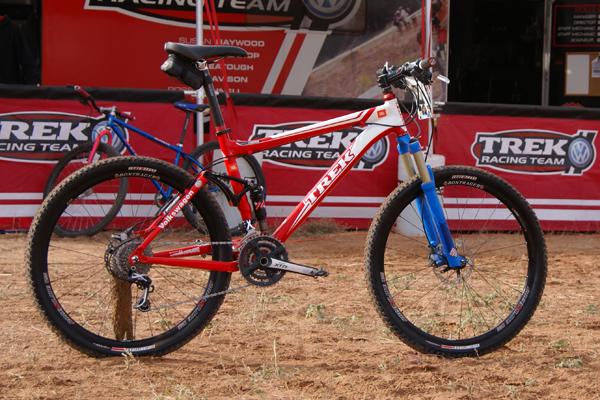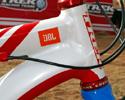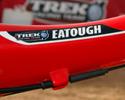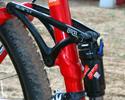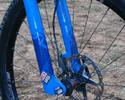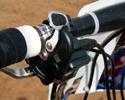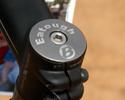
Recently on Cyclingnews.com |
Pro bikes, January 24, 2008
Chris Eatough's Trek-VW Trek Top Fuel
A balance of light weight and durabilityBy James Huang Trek-VW's Chris Eatough is the unequivocal king of 24-hour solo endurance mountain bike racing. Since turning professional in 1999, Eatough (say 'EE-TOFF') has dominated the discipline with six consecutive world solo championships, two US National solo titles, and countless wins at various other endurance events. At just 33 years of age, the British native that now calls the US state of Maryland his home shows no signs of stopping or slowing down and currently offers up no imminent plans for retirement, surely to the chagrin of the competition that eagerly awaits its chance in the spotlight. Eatough's successes on the race course are naturally the result of many hours of training but not likely of the type that most would expect. Although he obviously spends a full day in the saddle come race time, he rarely embarks on training rides that are longer than three to four hours. Longer days are tossed into the mix on occasion or prior to a major event, but otherwise he has built up such a solid foundation of base miles and fitness that most of the time is merely spent maintaining that level. In addition to his fitness, though, it is perhaps his meticulous preparation before races and the surgically precise nature of his racing style that set him apart from his competitors early on in his reign. All of his equipment is religiously gone over prior to events from tip to stern, bolt by bolt. Lights are charged, spares are collected. Any and all food is assembled and packaged in an easy-to-eat form. Courses are dutifully examined. Come start time, Eatough sets a fast pace right off the gun almost without fail to not only establish a quick lead whenever possible but also to inflict a mental blow on his rivals who must consistently try to answer the question of whether or not he can maintain that typically blistering early pace. Conveniently, only he knows the truth. Eatough also never actually stops to eat during 24-hour races, preferring to take in whatever calories are necessary on the bike to save time (and gain distance). A pair of identically outfitted (and prepared) machines accompanies him to every event and bikes are swapped out after each lap. As a result, Eatough is almost never on a bike that has seen more than an hour or two's worth of use on it since its last maintenance check and rarely suffers a mechanical out on course. All of this may sound a bit fanatical and over the top, but it's a formula that has been undoubtedly successful and one that Eatough is unlikely to deviate from any time soon. Eatough is likely also aided by the consistency and stability of his sponsorship arrangement having won each of his world championships aboard a full-suspension Trek. At last October's 24 Hours of Moab in Moab, Utah, the frighteningly consistent rider brought along two identical Trek Top Fuels, each outfitted with a brand-new Rock Shox SID Race fork and Monarch 3.3 rear shock, a full Shimano XTR group with Dual Control levers, and a heap of Bontrager components including a set of Race X Lite TLR Disc wheels, Race X Lite aluminium stem, and Race XXX Lite OS carbon flat handlebar. This latest Fuel's 'R1 Race Tuned Suspension' boasts essentially the same design used in the debut Fuel from nearly a decade prior, but the design has undergone iterative improvements over the years and its simple single-pivot configuration has proven to be a capable performer. We unfortunately didn't have a scale on hand to get an actual weight, but team mechanic Steve Borkoski pegged it at about 11.3kg (25.0lb). This figure isn't particularly impressive from a pure XC race machine standpoint, but the proven reliability of its build is likely worth the extra grams; even light bikes are heavy (and slow) when they have to be carried back to the pits. Moreover, Eatough occasionally opts for other machines from the Trek stable that may be better suited for the course at hand even if they're substantially heavier. "One of the great things about being a pro riding for Trek is that Chris can choose exactly what bikes he thinks suits the course," said Trek Mountain Bike Brand Manager Michael Browne. "You'll notice that at 24-9 in Wisconsin, he chose to ride different 69ers. During the BC Bike Race, he chose to ride Fuel EX's. And in other courses, he chooses to ride Top Fuels. For Moab, Chris thought the most appropriate bike was a Top Fuel, for reasons of weight, and the course not being as technical terrain as that of BC Bike Race." Curiously, though, Eatough was riding aluminium-framed Top Fuels instead of Trek's lighter and stiffer OCLV carbon model. Borkoski attributed the selection to an inventory issue, but Browne insisted that Eatough's selection was made purely by choice. Regardless, the aluminium frame's extra mass didn't seem to keep Eatough from doing what he does best. He won the 24 Hours of Moab comfortably, having knocked off fourteen laps of the dry, dusty, and fast course in 22 hours and posting a 1:41:59 lead over second place finisher Travis Macy. PhotographyFor a thumbnail gallery of these images, click here Images by James Huang/Cyclingnews.com
| |||||
Full specificationFrame: Trek Top Fuel, Alpha Red Aluminum, 90mm travel, 19.5"
frame Critical measurements Bottom bracket: Shimano XTR Hollowtech 2 FC-M970 |
Wheelset: Bontrager Race X Lite TLR Disc Bars: Bontrager Race XXX Lite OS Carbon Flat, 580mm Pedals: Shimano XTR PD-M970 Total bike weight: 11.3kg (25.0lb) (estimated) | ||||

